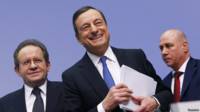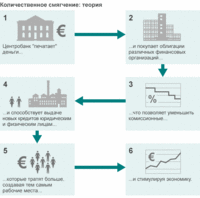- January 22, 2015
Post

The European Central Bank announced the launch of a massive quantitative easing, which is designed to increase the size of the money supply and stimulate the European economy.
Since March of this year, the ECB will buy government bonds on the secondary market at 60 billion euros per month until the end of September 2016, and possibly longer within the advertised program quantitative easing.
At the same time the ECB announced that interest rates in the euro area are kept at a record low of 0.05%, which they reached in September 2014.
In currency trading, the euro fell in London to a minimum of 11 years after the announcement that the European Central Bank has launched a program of quantitative easing. At the same time, the index of shares of European companies Stoxx Europe 600 up 0.8% – up to 360,84.
The ruble also several fastened to report on the measures of the ECB. After the minimum values at 76.06 rubles. / € at the session on Thursday, the Russian currency rose up to 74.10 rubles. / €.
The ECB President Mario Draghi said at a press conference that the program will be implemented as long as the rate of inflation in the eurozone will not reach 2%.
Earlier in many countries of the euro area since the beginning of the year deflation, with the risk of a sharp slowdown in growth or even stagnation of the economy, as businesses and consumers stop spending money waiting for further price reductions.
In these circumstances, the ECB is looking for ways to stimulate demand and consumption. Reducing the cost of borrowing may encourage banks to become more active credit policy, and cheaper loans can stimulate consumer demand.

This financial strategy has been used successfully in the US, where in the period from 2008 to 2014 carried out a large-scale quantitative easing program.
Britain and Japan has also conducted major programs aimed at increasing the money supply by buying securities.
According to Mario Draghi, the ECB program is aimed at countering two undesirable trends in the European economy.
“Dynamics reducing inflation is stronger than expected, and the main indicators of inflation close to historic lows – said Draghi. – In most countries, there is a weak eurozone growth, and the money and credit markets – the calm “.
At the same time, according to the head of the ECB, it is necessary to take measures to neutralize the high risk of a prolonged period of very low inflation.
What is the government bond
Governments usually borrow money in the financial markets by issuing bonds that are sold to investors. This bond is essentially an IOU. In exchange the price paid for the bonds, the Government undertakes to pay a percentage for a fixed period – for example, 4% for 10 years. At the end of this period, the investor returns the original value of the bond.
Such treasury bonds traditionally regarded as the most reliable form long-term investment. They are actively bought by pension funds, insurance companies and banks, as well as private investors. They represent an important part of the financial instruments, which have central banks.
So far, the ECB resisted proposals for conducting quantitative easing, although its president, Mario Draghi in July 2012, said that he would do everything necessary to maintain financial stability in the euro area.
Since then, the need for a massive credit issue only increased.
No comments:
Post a Comment